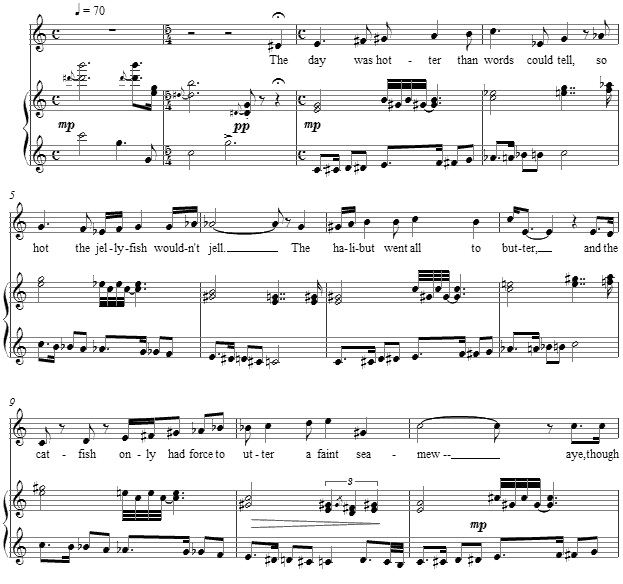Music and Texts of GARY BACHLUND
Vocal Music | Piano | Organ | Chamber Music | Orchestral | Articles and Commentary | Poems and Stories | Miscellany | FAQs
Don't You See? - (2010)
Katharine Lee Bates
for medium voice and piano
The day was hotter than words can tell,
So hot the jelly-fish wouldn't jell.
The halibut went all to butter,
And the catfish had only force to utter
A faint sea-mew -- aye, though some have doubted,
The carp he capered and the horn-pout pouted.
The sardonic sardine had his sly heart's wish
When the angelfish fought with the paradise fish.
'T was a sight gave the bluefish the blues to see,
But the seal concealed a wicked glee--
The day it went from bad to worse,
Till the pickerel picked the purse-crab's purse.
And the crab felt crabedder yet no doubt,
Because the oyster wouldn't shell out.
The sculpin would sculp, but hadn't a model,
And the coddlefish begged for something to coddle.
But to both the dolphin refused its doll,
Till the whale was oblidged to whale them all.[ 3 pages, circa 2' 35"]
Katharine Lee Bates
American songwriter, poet, author and educator Katharine Lee Bates (1859 - 1929) is best known for writing the text for "America the Beautiful." She published much children's literature, books about travel and volumes of poetry. This delightful bit of nonsense plays with words, as nouns, the names for the various fish on this hot day, tumble over into like sounding verbs and objects linked in the images of action. One might joke that her fish went fishing ("don't you see?) for some humor, and my appreciation of nonsense in language speedily suggested this as a musical setting.
The large arch in the accompaniment rises and falls by major triads over a chromatic line, and then by augmented triads, and finally by minor triads in first inversion. The form caused by this periodicity breaks the text into three groupings, the first grounded on C, yet not in C major for the scheme generates no true tonal center, except for forcing the cadences towards the dominant and then subdominant as if in C. The chromatic lines may be blurred with pedal as desired by the performers.
The second set of poetic lines begins with the center on A, as the melody line finds its way through this transposition.
The third and final set of lines centers on A flat, following generally the same scheme. with the final cadence returning to end in C.
The score for Don't You See? is available as a free PDF download, though any major commercial performance or recording of the work is prohibited without prior arrangement with the composer. Click on the graphic below for this piano-vocal score.



